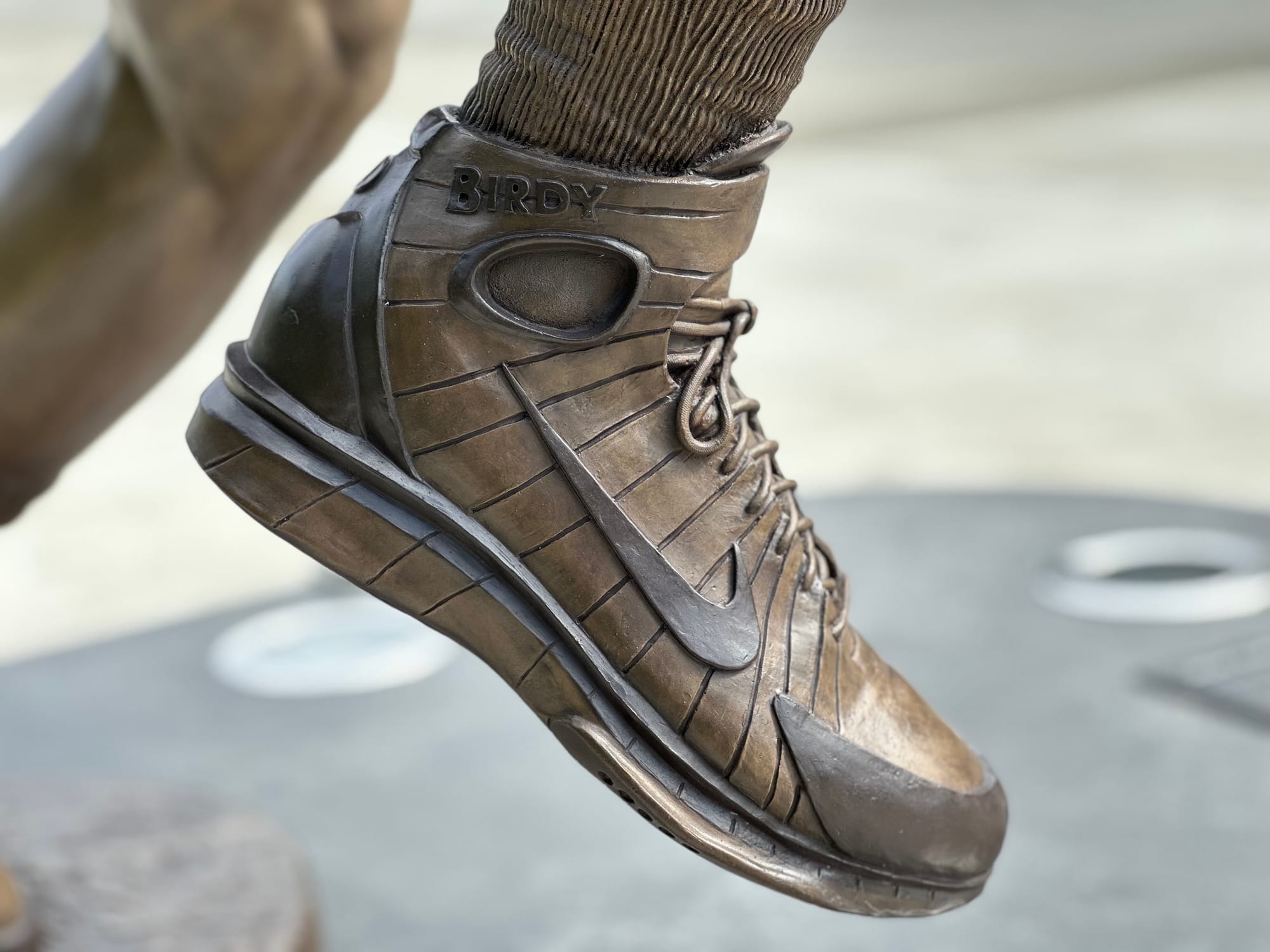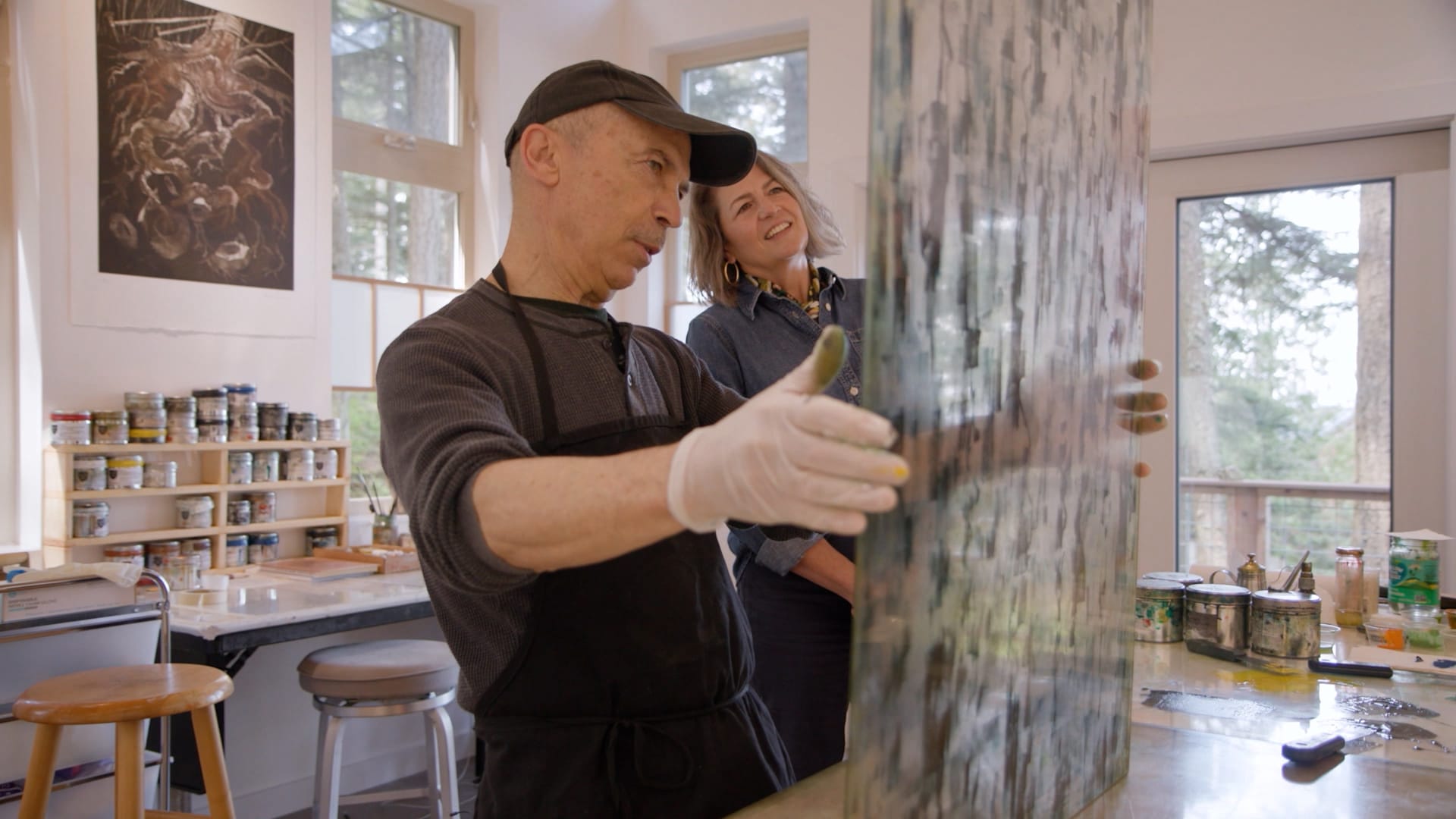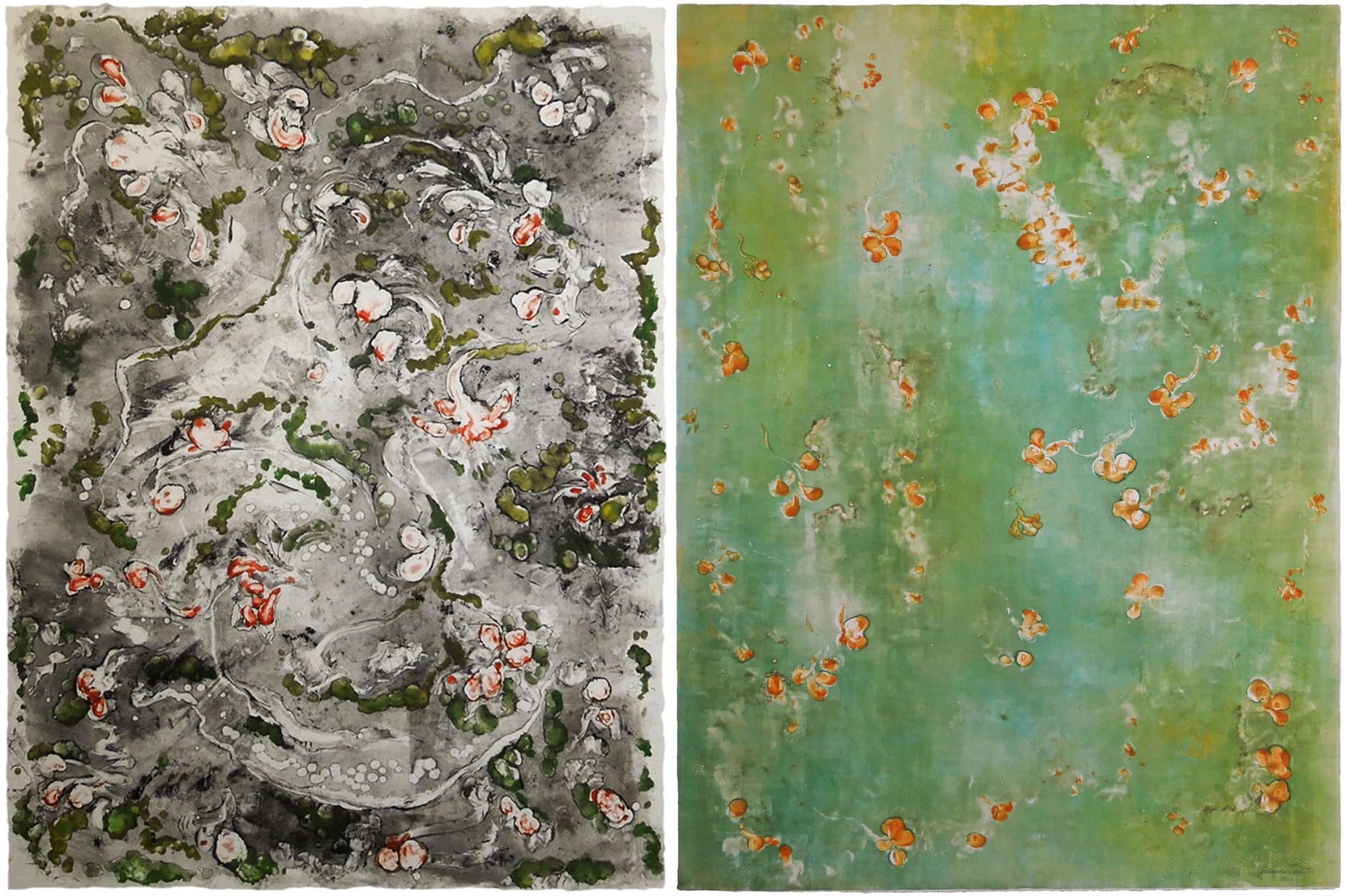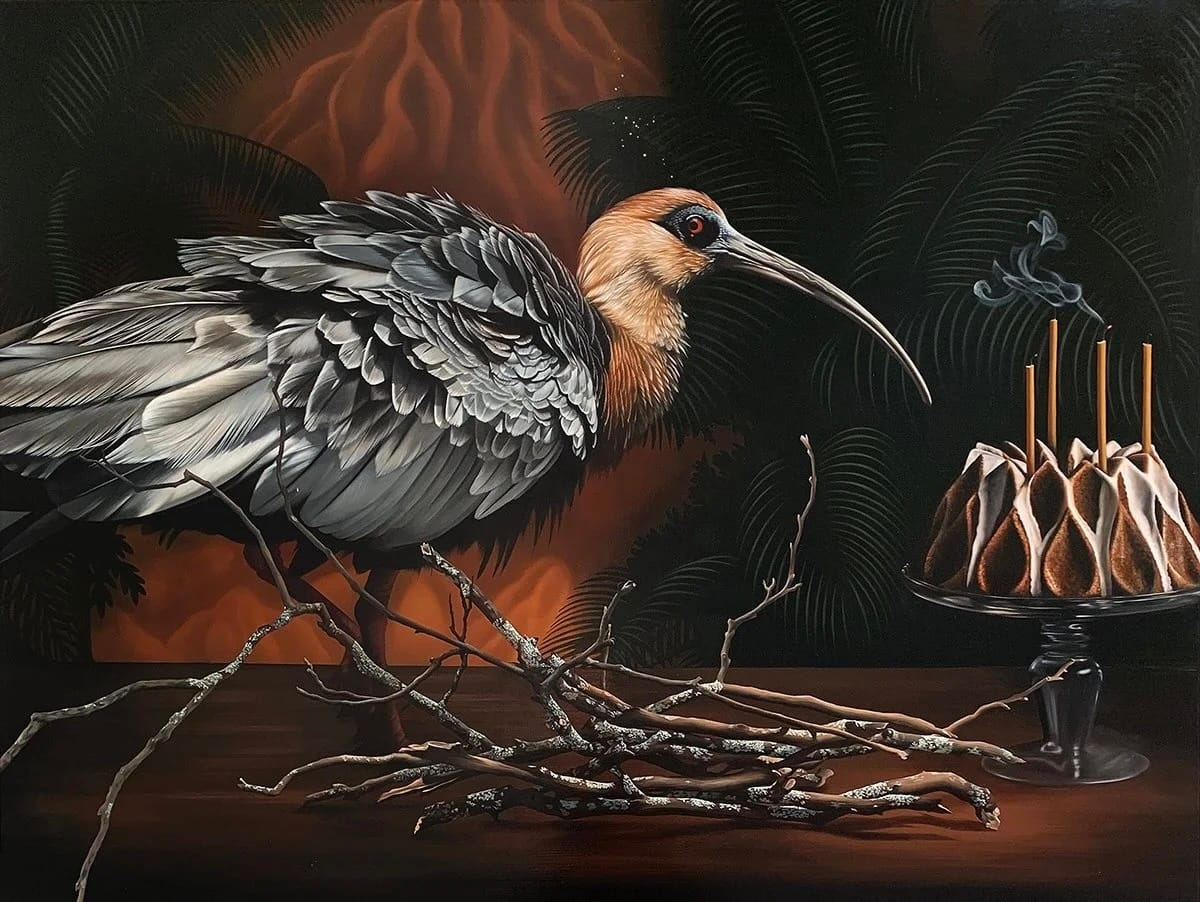Ever since it sprang up for the 1962 World’s Fair, Seattle Center has been a home for bronze sculptures. Take a self-guided walking tour and you might notice the same thing I did recently: Many of these works use the heavy medium to convey movement.
Everett Dupen’s Fountain of Creation (1962; originally installed in a much-loved wading pool), features a trio of sculptures including the midcentury minimalist “Flight of Gulls.” Harold Balazs’ “Walking Round Thing” (1980) is exactly that. Gloria Bornstein’s “Neototems” (1995) features a whale mother and calf swimming through the grass. And more recently, Gerard Tsutakawa contributed “Seawave” (2021), a rolling circle that nods to the tidal cycle.
Art x NW (formerly ArtSEA) is a weekly arts and culture newsletter from Cascade PBS. Read past issues and subscribe for more.
As of Sunday (Aug. 17), Seattle Center has another bronze sculpture in the movement mix: a statue of Seattle Storm basketball legend Sue Bird, near Climate Pledge Arena. I’ll confess I don’t pay much attention to sports statues unless they go horribly awry. Thankfully this one is a good likeness of the basketballer — the first WNBA player to receive a commemorative statue.

It was created by sculptors Julie Rotblatt Amrany and Omri Amrany, whose Illinois-based studio makes a lot of sports statues. That includes Edgar Martinez and Ken Griffey Jr., former Seattle Mariners now permanently at bat outside T-Mobile Park, as well as Sonics player and coach Lenny Wilkens, also recently installed near Climate Pledge Arena.
Humans have been making bronze sculptures since, well, the Bronze Age, but it’s still tough to get a realistic likeness. The teeth are often strange. A couple of the studio’s works have met with hilarity and fear (Harry Caray resembles a mushroom zombie from The Last of Us). But the Sue Bird image is pretty great — capturing everything from her dimples to her custom Nikes emblazoned with “Birdy” and her flying ponytail, which achieves cruising altitude as she prepares for a layup.
It was the airborne ponytail that caught my attention, because we don’t see many bronze ponytails in Seattle (not to mention statues of prominent women). With this hair detail, I place Sue Bird’s statue in a thematic flock with a couple other bronze sculptures at Seattle Center: David Lemon’s “Feminine One II” (2016), an abstract dancer reaching skyward; and Egon Weiner’s “Flame 2” (1962), a simple flicker curved and buoyant as a ponytail midflight.

It’s time for a new episode of our TV show Art by Northwest, this week featuring Orcas Island printmaker Eduardo Fausti. Born and raised in Argentina, in a small town at the foot of the Andes, Fausti emigrated to the U.S. as a young adult.
After spending years in San Francisco and then New York City, he and his partner wanted to get back to the West Coast — somewhere with a bit more peace and quiet. Fausti had never heard of the San Juan Islands when he saw them pop up on a real estate map. But like most people who visit Orcas Island, he was immediately smitten.
He had previously been working on mezzotints — a painstaking 17th-century printing process that involves repeatedly carving into copper plates. (Every time I’ve mentioned this medium to other printmakers, they say something like, “Whoa, mezzotints are a master skill.”)
But once immersed in the silence and natural sounds of Orcas, he yearned for a quicker way to express his experience of the environment. He landed on monotypes, in which he paints what’s essentially a colorful abstract painting directly on Plexiglass, then runs it through the press for a single paper copy. Afterward, he washes off all the paint and starts anew on the same matrix.

Fausti emphasizes that these shapes and patterns “are not a direct representation of what I see.” They aren’t meant to be literal landscapes, he told me, but “more like a representation of my awareness of the island … my emotional response to the solitude and silence.” Spend some time staring into the works and you start to sense movement, whether ripples across a bay or a breeze through tall cedars.
He still works on mezzotints, too, and showed me a new one he’s crafting — of the stunning view outside his window: the bay, evergreens and surrounding mountains. The piece includes a crescent moon, which Fausti noted with a laugh still looks “backward” to him, having grown up in the Southern Hemisphere. Add to that the inherent reverse-image in the printing process and you have a double-back-flip brain teaser.
One funny sidebar that surprised me in putting together this episode: how many people — even longtime locals — assume Orcas Island is named for the killer whales. It isn’t. (I’ve never seen so many “mind-blown” emojis from early viewers and readers.) Watch the profile of Eduardo Fausti to find out where the island really gets its name. And also to experience a beautiful immersion in the Orcas landscape, courtesy of his prints.
Missed Episode 1? Watch the profile of Yup’ik mask carver Jennifer Angaiak Wood.

A few more suggestions for upcoming arts & culture activities …
< Just in time for “back to school,” the awesome Silent Movie Mondays series at The Paramount is showing The Freshman (Aug. 25), a 1925 comedy starring Harold Lloyd as an unpopular college kid. Bonus: Tyler Pattison on the Mighty Wurlitzer organ and Paul Hansen on Foley Sound.
< It’s the final Saturday of the monthlong Thing musical festival at Remlinger Farms in Carnation (Aug. 23), with a killer lineup including The Roots, Cory Wong, Tune-Yards and Tunde Adebimpe (of TV on the Radio).
< Local contemporary dance company Whim W’Him is bringing back its wonderful pop-up in the parks series (Aug. 21, 27, 29), with 19-minute outdoor performances at Westlake Center, Martha Washington Park, Jefferson Park and the AIDS Memorial Pathway at Cal Anderson Park.
< Longtime Seattle writer Trisha Ready reads from her new memoir-novel-experiment Nobuko, which involves a Japanese crime syndicate, a young American English teacher and “a woman who lives in a rustic cabin and makes teeth.” (Aug. 22 at Elliott Bay Books).
< And speaking of birds bronzed and feathered … flap your way to For Its Own Sake (through Sept. 6 at Roq La Rue), a show of new work by Josie Morway. These hyperrealistic, meticulously detailed oil paintings of birds and other creatures are an ode to nature’s exuberance and very fancy feathers.
Looking for more regional arts coverage? Check out Art by Northwest, a new television series on Cascade PBS featuring artists from all over Washington. Season 2 episodes are releasing weekly from August 7 through October 2.


